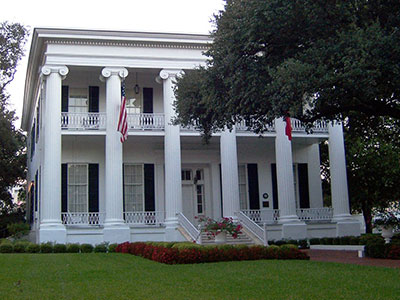
The Governor’s Mansion in Austin, Texas, was originally built in 1854 and has housed all of the governors for the state of Texas ever since.

The bottom floor of the original mansion was 3,000 square feet in the shape of a rectangle that was 60 feet long and 50 feet wide. If the Governor had wished to expand just the bottom floor of the original building but had to limit the total size of the bottom floor to be less than or equal to 4,200 square feet, what range of distances could be added to the length and width?
A. Between 30 and 40 feet could be added to each dimension.
Incorrect. Be sure to set up your inequality so that you have the original dimensions plus an unknown that will multiply and be less than or equal to 4,200 square feet.
B. Between 50 and 60 feet could be added to each dimension.
Incorrect. Those are the dimensions of the original bottom floor. Set up your inequality so that you have the original dimensions plus an unknown that will multiply and be less than or equal to 4,200 square feet.
C. Between 10 and 120 feet could be added to each dimension.
Incorrect. If you found 10 and 120 as roots, now use them to find the interval that will satisfy the inequality.
D. Between 0 and 10 feet could be added to each dimension.
Correct!
Find the solution to 11 ≥ x2 + x − 1.
A. x ≤ -4
Incorrect. There are values in this interval that satisfy the statement of inequality; however, there are more values.
B. x ≥ 3
Incorrect. There are values in this interval that satisfy the statement of inequality; however, there are more values.
C. -4 ≤ x ≤ 3
Correct!
D. No solution
Incorrect. Check your inequality symbol from the original problem and then select test values based on the roots that you found.
A certain rectangle has a length that is 3 times its width. What are the possible widths of the rectangle so that the area will be less than 54 centimeters squared?

A. The width of the rectangle will have to be less than 4.2 centimeters and more than 0 centimeters.
Correct!
B. The width of the rectangle will have to be between -4.2 centimeters and 4.2 centimeters.
Incorrect. In the context of the problem, it is impossible for the width of the rectangle to be negative.
C. The width of the rectangle will have to be greater than 4.2 centimeters.
Incorrect. Values greater than 4.2 do not satisfy the inequality. Make sure you are finding values that make the total area less than 54 square centimeters.
D. The length of the rectangle can only be 4.2 centimeters.
Incorrect. Make sure that you are looking at the intervals created by the roots to the quadratic to select test points, not the roots themselves.
Find the solution to x2 < -14x – 49.
A. x > -7
Incorrect. The values greater than -7 do not satisfy the inequality.
B. x < -7
Incorrect. The values less than -7 do not satisfy the inequality.
C. All real numbers
Incorrect. Since the inequality was strictly less than, even zero is not included in the solution.
D. No solution
Correct!

A rock is dropped off of a cliff that is 362 feet high into the water below. At what time interval will the rock be between 300 and 315 feet? Use the equation h(t) = -16t2 + vot + ho.
A. Between 0 and 1.6 seconds
Incorrect. Remember that the sign of the inequality will change when you multiply or divide by a negative. Also be sure you have set up the problem as a compound inequality.
B. Between 1.7 and 2.0 seconds
Correct!
C. Between 2.1 and 3.0 seconds
Incorrect. Check your steps and if needed, you may want to break apart the compound inequality into two separate problems.
D. Between 3.0 and 4.0 seconds
Incorrect. Be sure that you are taking the square root correctly after you have isolated the variable.